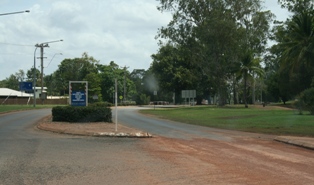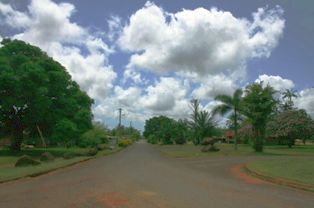| Location | Queensland |
|---|---|
| Coordinates | 15°15′27.4″S145°18′51″E / 15.257611°S 145.31417°E Coordinates: 15°15′27.4″S145°18′51″E / 15.257611°S 145.31417°E |
| Built | 1885 |
Elim Aboriginal Mission, Queensland was an Aboriginal mission in Queensland, Australia.
| Location | Queensland |
|---|---|
| Coordinates | 15°15′27.4″S145°18′51″E / 15.257611°S 145.31417°E Coordinates: 15°15′27.4″S145°18′51″E / 15.257611°S 145.31417°E |
| Built | 1885 |
Elim Aboriginal Mission, Queensland was an Aboriginal mission in Queensland, Australia.
This mission was established in 1885 on the north shore at Cape Bedford near Cooktown in Queensland. While it initially flourished, Elim's future became grim and the people were relocated to Hope Vale. At the beginning of World War II the people were relocated to Woorabinda Aboriginal Mission.
Over the next 10 years approximately a quarter of the people relocated to Woorabinda from Hope Valley died. In 1949, the people returned home to a new site called Hope Vale. Hope Vale was the first community in Queensland to receive land under Deed Of Grant In Trust arrangements. The 1996 census population of Hope Vale was 671.

Cape York Peninsula is a large peninsula located in Far North Queensland, Australia. It is the largest unspoiled wilderness in northern Australia. The land is mostly flat and about half of the area is used for grazing cattle. The relatively undisturbed eucalyptus-wooded savannahs, tropical rainforests and other types of habitat are now recognised and preserved for their global environmental significance. Although much of the peninsula remains pristine, with a diverse repertoire of endemic flora and fauna, some of its wildlife may be threatened by industry and overgrazing as well as introduced species and weeds.

The Guugu Yimithirr, also spelt Gugu Yimithirr and also known as Kokoimudji, are an Aboriginal Australian people of Far North Queensland, many of whom today live at Hopevale, which is the administrative centre of Hopevale Shire. At the 2011 census, Hopevale had a population of 1,005 people. It is about 46 kilometres (29 mi) from Cooktown by road. It is also the name of their language. They were both a coastal and inland people, the former clans referring to themselves as a "saltwater people".

Weipa is a coastal mining town in the local government area of Weipa Town in Queensland. It is the largest town on the Cape York Peninsula. It exists because of the enormous bauxite deposits along the coast. The Port of Weipa is mainly involved in exports of bauxite. There are also shipments of live cattle from the port.

Laura is a rural town and locality in the Shire of Cook, Queensland, Australia. In the 2016 census the locality of Laura had a population of 228 people.

Lakeland is a rural town and locality in the Shire of Cook, Queensland, Australia. In the 2016 census, the locality of Lakeland had a population of 299 people.

Hope Vale is a town within the Aboriginal Shire of Hope Vale and a coastal locality split between the Aboriginal Shire of Hope Vale and the Shire of Cook, both in Queensland, Australia. It is an Aboriginal community. In the 2016 census, the locality of Hope Vale had a population of 1,015 people.

Coen is a town and coastal locality in the Shire of Cook, Queensland, Australia. The town of Coen is inland on the Peninsula Developmental Road, the main road on the Cape York Peninsula in far northern Queensland. In the 2016 census, Coen had a population of 364 people.

Wujal Wujal is a rural town and locality in the Wujal Wujal Aboriginal Shire, Queensland, Australia. In the 2016 census, Wujal Wujal had a population of 282 people. It is an Aboriginal community.
The Cape York Institute for Policy and Leadership, also known as the Cape York Institute, is an Australian public policy organisation which researches and implements welfare reforms to reduce social inequalities between Indigenous and Non-Indigenous peoples living in Cape York. The Cape York Institute was founded by lawyer, academic and Indigenous welfare advocate Noel Pearson. Established in July 2004, the organisation was developed in collaboration with the people of Cape York and Griffith University. The Institute prepares reports and submissions to the Australian Federal Government, identifying priority areas of welfare and economic reform to restore social norms within the Cape York communities. To deliver welfare and economic reform, the Institute engages with a number of partner organisations including the Cape York Partnerships, Family Responsibilities Commission, Balkanu Cape York Development Corporation and the Cape York Aboriginal Australian Academy. The Cape York Institute receives Commonwealth and Queensland State Government funding to support Welfare Reform Projects in areas of Indigenous education, employment, families and housing.

Woorabinda is a rural town and locality in the Aboriginal Shire of Woorabinda, Queensland, Australia. In the 2016 census, Woorabinda had a population of 962 people. It is an Aboriginal community.

Kowanyama is a town and coastal locality in the Aboriginal Shire of Kowanyama, Queensland, Australia.
Mapoon is a coastal town in the Aboriginal Shire of Mapoon and a locality split between the Aboriginal Shire of Mapoon and the Shire of Cook in Queensland, Australia. In the 2016 census, Mapoon had a population of 317 people.
Napranum is a remote town in the locality of Mission River in the Aboriginal Shire of Napranum, Queensland, Australia. At the 2016 census, the town of Napranum had a population of 950.

The Shire of Cook is a local government area in Far North Queensland, Australia. The Shire covers most of the eastern and central parts of Cape York Peninsula, the most northerly section of the Australian mainland.
A Deed of Grant in Trust (DOGIT) is the name for a system of community-level land trust established in Queensland to administer former Aboriginal reserves and missions. They came about through the enactment by the Queensland Government of the Community Services Act 1984 and Community Services (Aborigines) Act 1984 in 1984, allowing community councils to be created to own and administer former Aboriginal reserves or missions under a Deed of Grant in Trust). The trusts are governed by local representatives who are elected every three years to councils called Incorporated Aboriginal Councils. These councils have the power to pass by-laws, appoint police for the community, and are responsible for maintaining housing and infrastructure, running the Community Development Employment Program and issuing hunting, fishing and camping permits. As such, they work much like a local government, but are different in character as they own the land they administer on behalf of the community.

The Aboriginal Shire of Kowanyama is a special local government area which is located on western Cape York Peninsula in Queensland, Australia. It is managed under a Deed of Grant in Trust under the Local Government Act 2004.
The Cape Bedford Mission was the first Christian mission on the Cape York Peninsula of Queensland, Australia. It is the oldest surviving mission in northern Queensland.

Cooktown is a coastal town and locality in the Shire of Cook, Queensland, Australia. Cooktown is at the mouth of the Endeavour River, on Cape York Peninsula in Far North Queensland where James Cook beached his ship, the Endeavour, for repairs in 1770. Both the town and Mount Cook which rises up behind the town were named after James Cook.
Eric Deeral was an Australian politician who was the second Australian Aboriginal person elected to an Australian parliament and the first to a state parliament.

The Aboriginal Shire of Hope Vale is a local government area in Far North Queensland, Queensland, Australia, north of the town of Cooktown. The majority of the Shire consists of Deed of Grant land that is held for the benefit of Aboriginal people particularly concerned with the land and their ancestors and descendants.